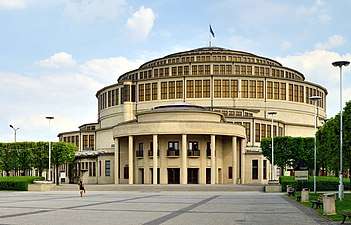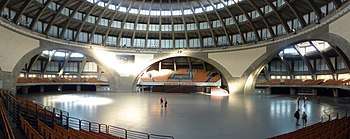Centennial Hall
The Centennial Hall (Polish: Hala Stulecia; German: Jahrhunderthalle), formerly named Hala Ludowa ("People's Hall"), is a historic building in Wrocław, Poland. It was constructed according to the plans of architect Max Berg in 1911–1913, when the city was part of the German Empire. Max Berg designed Centennial Hall to serve as a multifunctional structure to host "exhibitions, concerts, theatrical and opera performances, and sporting events."[1] The hall continues to be used for sporting events and concerts.
 Centennial Hall after renovation in 2009 | |
| Full name | Hala Stulecia |
|---|---|
| Former names | Hala Ludowa |
| Location | Wrocław, Lower Silesia, Poland |
| Coordinates | 51°06′25″N 17°04′38″E |
| Operator | City Hall Company Ltd. of Wrocław |
| Capacity | Boxing: 11,000 Handball: 8,500 Basketball: 10,000 Volleyball: 10,000 |
| Construction | |
| Broke ground | 1911 |
| Built | 1913 |
| Opened | 20 May 1913 |
| Renovated | 2009–2011 |
| Architect | Max Berg |
| Main contractors | Dyckerhoff & Widmann AG (Dywidag) |
| Tenants | |
| Śląsk Wrocław (Major attendance games) | |
| Official name | Centennial Hall in Wrocław |
| Type | Cultural |
| Criteria | i, ii, iv |
| Designated | 2006 (30th session) |
| Reference no. | 1165 |
| State Party | Poland |
| Region | Europe and North America |
As an early landmark of reinforced concrete architecture, the building became one of Poland's official national Historic Monuments (Pomnik historii), as designated April 20, 2005, together with the Four Domes Pavilion, the Pergola, and the Iglica. Its listing is maintained by the National Heritage Board of Poland. It was also listed as a UNESCO World Heritage Site in 2006.
History
It was in the Silesian capital of Breslau where, on 10 March 1813, King Frederick William III of Prussia called upon the Prussian and German people in his proclamation An Mein Volk ("To My People") to rise up against Napoleon's occupation. In this proclamation king Frederick also created the Iron Cross award, which later became the most famous German military honour and symbol. In October of that year, at the Battle of Leipzig, Napoleon was defeated.
The opening of the hall was part of the celebration commemorating the 100th anniversary of the battle, hence the name. Breslau's municipal authorities had vainly awaited state funding and ultimately had to defray the enormous costs out of their own pockets. The landscaping and buildings surrounding the hall were laid out by Hans Poelzig and were opened on 20 May 1913 in the presence of Crown Prince William of Hohenzollern. The grounds include a huge pond with fountains enclosed by a huge concrete pergola in the form of half an ellipse. Beyond this, to the north, a Japanese garden was created. The Silesian author Gerhart Hauptmann had specially prepared a play Festspiel in deutschen Reimen for the occasion, however the mise-en-scène by Max Reinhardt was suspended by national-conservative circles for its antimilitaristic tendencies.
After the memorial events, the building served as a multi-purpose recreational building, situated in the Exhibition Grounds, previously used for horse racing. It was largely spared from the devastation of the WW II (Siege of Breslau). After the war, when the city (together with most of historical Silesia) had become part of the Republic of Poland according to the 1945 Potsdam Agreement, the hall was renamed Hala Ludowa ("People's Hall") by the communist authorities. In 1948, a 106 m (348 ft) high needle-like metal sculpture called Iglica was set up in front of it. The hall was extensively renovated in 1997 and in 2010. Recently the Polish translation of the original German name, Hala Stulecia, became official.
Centennial Hall hosted EuroBasket 1963 and a preliminary round group of the EuroBasket 2009 tournament.[2]
Following the renovation in 2009–11, the arena can now hold 10,000 people. In october 2014, the building received a $200,000 renovation grant from the Getty Foundation, as part of the Keeping It Modern grant program that was created a month earlier by the American foundation.[3]
Architecture

The cupola modeled on the Festhalle Frankfurt was made of reinforced concrete, and with an inner diameter of 69 m (226 ft) and height of 42 m (138 ft) it was the largest building of its kind at the time of construction. The symmetrical quatrefoil shape with a large circular central space seats 7,000 persons. The dome itself is 23 m (75 ft) high, made of steel and glass. The Jahrhunderthalle became a key reference for the development of reinforced concrete structures in the 20th century.
At the centre of the structure a superior dome with lantern is situated. Looking from the inside, there is a clearly visible pattern of the Iron Cross[4] at the top of the dome; for this reason the centre of the structure was shrouded during the Communist era in Poland.[5]
The hall was originally provided with a Sauer pipe organ built by Walcker Orgelbau, which then, with 15,133 pipes and 200 stops, ranked as the world's largest. On 24 September 1913, Karl Straube was the first to play it, performing Max Reger's Introduction, Passacaglia and Fugue, Op. 127, specially composed to celebrate the occasion. Most parts of the organ were transferred to the rebuilt Wrocław Cathedral after World War II.
Access
The hall lies east of the city centre, but can easily be reached by tram or bus.
The hall is open daily to visitors for a small entrance fee. There are several programs including the Hall, Discovery Center and videomapping and the Plastic Panorama of Old Lviv.
The building and surroundings is frequently visited by tourists and locals. It lies close to other popular tourist attractions, such as the Wrocław Zoo, the Japanese Garden, and the Pergola with its Multimedia Fountain.[6]
References
- Cervinkova, Hana; Golden, Julia (2014). Gonzalez, ed. "Centennial Hall in Wroclaw: Re-Envisioning A Protected Urban Landscape Against the Backdrop of Changing European Borders and Identities". Landscape Anthropology in European Protected Areas (Valencia, Spain).
- Kibice wywalczyli nam polskie mecze Archived 2009-04-14 at the Wayback Machine, 15 January 2007
- Anna Cymer, Wrocław’s Centennial Hall Receives Getty Foundation's Keeping It Modern Grant, Culture.pl, 8 October 2014
- Cf. a photo
- Disputed Memory: Emotions and Memory Politics in Central, Eastern and South-Eastern Europe Front Cover Tea Sindbæk Andersen, Barbara Törnquist-Plewa
- "Centennial Hall | Hala Stulecia – Obiekt Światowego Dziedzictwa UNESCO". halastulecia.pl. Retrieved 2019-05-08.
External links
| Wikimedia Commons has media related to Centennial Hall. |
- Official site (in Polish and English)
- Century Hall at Structurae
- archINFORM - Centennial Hall
- Videomapping
| Preceded by Belgrade Fair Belgrade |
Eurobasket Final Venue 1963 |
Succeeded by Palace of Sports of the Central Lenin Stadium Moscow |